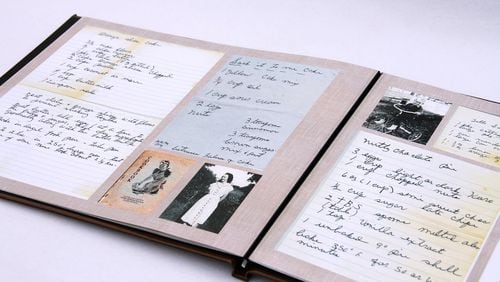Six easy steps to preserve family recipes
Valerie J. Frey, author of “Preserving Family Recipes: How to Save and Celebrate Your Food Traditions,” suggests these six ideas for those who want to start documenting their family food traditions.
1. Write personal cooking notes on family recipes and on favorite recipes from your cookbooks.
2. Mark favorite recipes or compile them in some manner so that your family members know which ones are important to you.
3. Don’t underestimate the appeal of simple recipes. What is common now may be rare later. Don’t let it slip away.
4. Start small: Even just one family recipe passes down memories and traditions.
5. Add stories as well as family facts to recipes. Even noting just the name of the cook who created the dish is a great start to preserving history associated with that recipe.
6. Play with your food: Save a copy of the recipe as is, then begin experimenting with the recipe to create a version that suits your taste buds and that of your family.
Of all the food stories I have written, the one most meaningful to me is titled "From Poland, With Love." It recounts my quest to re-create the pierogi my father enjoyed as a kid.
My dad’s Polish mother passed away long before I was conceived, so when I embarked on the project, she wasn’t available for kitchen consultation. Nor had her recipe been written down. But my dad and my aunt, as well as some Polish cookbooks, steered me toward something akin to the dumplings that my grandmother served her kids during their childhood in Chicago.
During the recipe sleuthing process, I connected in a different and meaningful way with my father, my aunt and even the grandmother I never met. I served that reimagined pierogi to my father at a family feast in December 2011. He passed away in 2015.
I thought about this recipe and other family favorites — my mom’s banana bread, the Christmas tree-shaped sweet rolls she baked every holiday season, my aunt’s square sausage pizza, my mother-in-law’s Stuck Together Rice — while attending a lecture this past November at the Georgia Archives in Morrow. Valerie J. Frey, author of “Preserving Family Recipes: How to Save and Celebrate Your Food Traditions” (UGA Press), was speaking about the merits of saving heirloom recipes.
Why save a family recipe? The obvious answer is so that you and future generations can cook a relative’s dish long after the creator has gone from this earth. There is also a social history value to these recipes. A recipe puts “flesh on the bone,” as Frey put it.
Every recipe has a story, Frey explained in her talk. The recipe has an origin (or provenance, to use a more academic term), it tells us who used it, how it was served and how it has changed over time. There are tales connected to it, and it fits into a larger family and cultural history.
“When an old man dies, a library burns,” goes the African proverb. When it comes to cherished family recipes, how can you preserve those food traditions so that when a cook in the family passes away, the recipe lives on, as does that person’s legacy?
In her book, Frey offers ideas for preserving recipes while the original cook is still alive, as well as for reclaiming what she calls “orphan” recipes, which is what my pierogi recipe would be classified as.
“When there is a recipe or a dish and the cook that invented it is gone, people think of that as a dead end. But there is historical research,” Frey explained. “You can, bit by bit, turn yourself into an expert on a recipe. What was a dead end, you’ve transformed into an avenue.” By interviewing family members and working with original documents and secondary sources, Frey now has recipes from all four of her great-grandmothers. “These are people that I never met. I know them through their recipes.”
The holidays are a prime opportunity to tap into the rich historical food knowledge of the cooks in your family. As you gather for meals at the table, there are stories to be told about the dishes you love and the cooks who first created them. Even the generations that have since adapted recipes to suit personal tastes, modern units of measurement and the availability of present-day ingredients have valuable input to give.
If you venture into the kitchen during family get-togethers, you can watch them cook since there are “innate things that a recipe creator knows that are not written in the recipe,” Frey said. “That person has an idea of what they are going for in their head and they are navigating toward it.” Thus, holiday meal preparations provide the chance not just to write out the recipe, but also take notes and ask questions, she said.
With a background in information science and years of archival experience, Frey has most of us beat when it comes to gathering and preserving recipes. Her personal collection of heirloom recipes is extensive. She has both a digital recipe collection and, for use in the kitchen, a binder with plastic protective sleeves. For each recipe, she tries to include a typed version of the recipe (with ingredients and procedure), historical notes, cooking tips, an image of the original (often handwritten) recipe and a photo of the cook who created it. She has compiled numerous family cookbooks and turned those into hardbound keepsakes.
But those of us who don’t have the time or energy to go to such depths can still take basic steps to preserve recipes. If cooking is a hobby for you, Frey suggests that you mark your favorite recipes in some way so that your family knows which ones matter most to you. “Sometimes, people have hundreds of recipes; no one knows which ones you really like,” Frey said. Jot down cooking tips on your recipes to provide others with important clues to achieving the same results when they attempt to make the dish.
Frey also recommends scanning and saving original handwritten recipes before they become impossible to read because of kitchen spills or the paper becoming frail and worn.
Frey shared some of these ideas with me during a follow-up phone interview a day before Thanksgiving. Among the dishes I looked forward to eating during that big feast was my husband’s uncle’s spinach casserole. It’s a fairly uncomplicated dish, but I salivate every year when Uncle Carl and Aunt Nancy walk in the doorway with it, the glass pan so piping hot that they wrap it in kitchen towels.
I heeded Frey’s advice and asked for the recipe. A few days later, Nancy texted me a photo of it. I can’t imagine a Thanksgiving without this spinach casserole. Now I don’t have to.
What’s your favorite family recipe? Now’s the time to nab it. Just don’t let it slip away.
About the Author







